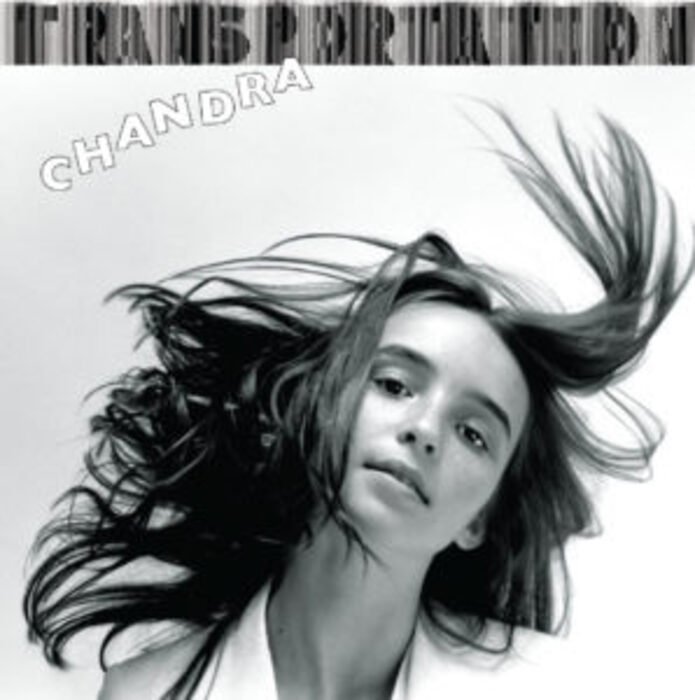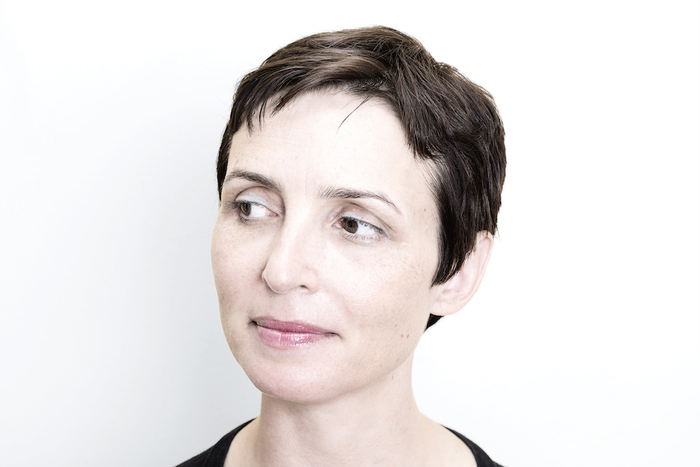Purveyor of: Post-punk dance-rock for the ages, and all ages
File next to: B-52s, Bush Tetras, Basquiat, Bile Sister
Playing: Wavelength Music Festival 17 – Night 1, Friday Feb. 17 @ The Garrison. Get festival passes here!
The post-punk era of New York in the early ‘80s is often thought of as a hedonistic time and place. But the NYC of James Chance and Lydia Lunch, ESG and Liquid Liquid, Jean-Michel Basquiat and Downtown ‘81, was also a hotbed for the innocent self-expression of childhood. Chandra Oppenheim, daughter of pioneering conceptual artist Dennis Oppenheim, began making music at a very young age along with two older friends of her father’s, and released a seminal EP, Transportation, in 1980, when she was just 12 years old. These songs are timeless dance-punk tracks that stand up alongside contemporary classics from The B-52s or Bush Tetras, and the record became a cult favourite long after Chandra gave up on music in 1982 to focus on her schooling.
After many years out of print, Transportation was reissued in 2009 by Cantor Records, the label run by Edmonton’s Aaron Levin, co-founder of the Weird Canada blog. Enthusiasm for Chandra’s music in Canadian underground music circles led to a concert in Toronto in 2014, and now the Chandra band is an ongoing concern, with the grown-up Oppenheim backed up by a group of Toronto all-stars from Bile Sister, Century Palm, and New Chance. A second reissue of Transportation also came out in 2014 on Oppenheim’s own imprint, Rain Boot Records. And Chandra’s resurgence reached even further in 2016, when her track “Subways” was sampled by popular Australian electronica duo The Avalanches. Jonny Dovercourt caught up with Chandra from her home in Portland, Maine, advance of their show opening up Wavelength Music Festival 17 this Friday at The Garrison.
The Chandra story is obviously not your average band origin tale. How did you get the idea to start a band at the age of 12? And how do you go about finding bandmates when you’re still a pre-teen?
The band, Chandra, formed when two friends of my father’s, Eugenie Diserio and Steven Alexander, of The Dance, were looking for an additional project. They knew that I had created and performed some performance art pieces when I was younger, seven years old, and that I had started writing songs. They asked if I would be interested in fronting a band. I was nine years old when we started rehearsals. Initially, the band was made up of the members of The Dance. After a year or so, we held auditions for teenage musicians, and invited a friend of mine to join the band and The Chandra Dimension was formed.
What are your fondest memories of that time?
I loved songwriting and performing, but what stands out most in my memory are the rehearsals. I liked the process of creating and fleshing out the songs with the band. I looked forward to our bi-weekly rehearsals, at our grungy Hell’s Kitchen rehearsal space. I am sure there was a lot that I missed and didn’t understand in the conversations of the adults around me. I was surrounded by things that were new to me, like the percussion player, who played found objects and did yoga. Back in 1980, not everyone did yoga. Somehow, I felt and home and thrived in this environment.
Another memory that stands out is when some friends came to see me play at Peppermint Lounge. I think it was the only time my friends got to see me play. I’m not sure how a bunch of ten-year-olds were allowed in; different times, I guess. After soundcheck, before the doors opened, we all ran around the vast, empty club, getting dizzy looking up at the 40-foot ceilings, yelling and going nuts. I’m pretty sure we were doing cartwheels on the dance floor.
What was the most difficult thing about creating and performing music at such a young age?
That’s the thing, it was effortless. Everything was taken care of for me. All I had to do were the things that came naturally to me. The only difficulty or conflict came during times that I felt torn between my music life and my school life. I needed to be focused during rehearsal, yet I felt a pull to get my homework done. I would sit on the ratty rehearsal studio couch doing my homework during every break, every chance I got. In this case, homework was distracting me from what in hindsight was the more important work. But, from my perspective as a ten-year-old, giving school my all was the only option, a self-imposed pressure. So, this was confusing for me. Believe me, I wouldn’t be confused now. I would prioritize making music!
Are there people from that time period that are still in your life?
I have been back in touch with Eugenie and Steve since the 2009 Cantor Records reissue. Since then, we have worked together on licensing our songs for various things: a film, a compilation, the “Subways” sample for The Avalanches’ new album. It has been great to be in touch with them and see them again. Also, Louis Watterson, who played bass in the original incarnation of Chandra, played on my 2015 album, A Slightly Better Idea. I have stayed in touch on and off with my childhood friend who played in The Chandra Dimension. And the bass player and drummer from this band have been in touch with me within the past couple of years, sharing their excitement over the attention the music has been getting.
What does it feel like to hear your twelve-year-old self sing on the record?
I understand why it grabs people. I was completely present and self-confident in my message and in my delivery. I hear unyielding, unobstructed conviction. My adult self can’t compete with that! I am grateful that this was captured, that it survived. And although I have lived a lifetime since I recorded those vocals, I still remember the feelings and thoughts that ran through me as I wrote and sang the songs.
How did you connect with Aaron Levin to re-release Transportation on Cantor Records in 2009?
Aaron Levin contacted me through my father, because my father was easier to find. Aaron told me he was launching a label and wanted to reissue Transportation. He was excited to hear that I had four never-before-released studio tracks recorded in 1982. He included these on the reissue. I see the reissue on Cantor Records as a turning point, giving this music a second life.
Is there any other unreleased Chandra music out there, that might see the light of day?
Yes! There are two songs that will be released this year. They were recorded on a 4-track cassette recorder in 1983. We will play one of them, “Day Without Success,” on Friday. Other than that I have only lo-fi rehearsal tapes. They have been digitized but will remain in the “archives” for the time being.
What is your favourite thing about performing with your Toronto-based Chandra band?
I love my bandmates! They are lovely, supportive and enthusiastic and they are talented, dedicated musicians. I also love spending time in Toronto, and pretending that I live there. This band has been an unexpected and welcome development in my music life. I get to hear the music live again, after over 35 years. When we first stared rehearsing, I would just start cracking up because I couldn’t believe it, the spot-on synth sounds, the vibration of the rhythm section, and all of the quirky instrumentation, like the melodica, sitting on top. My laughter came out of disbelief, gratitude and pure joy, of course. More specifically, as singer, it feels great to have the vocal punch that we get with three singers, with Julie Reich and Victoria Cheong often doubling the lead vocal and creating dynamics and finely tuned punctuation. It gives the words the power they require.
You have a new project, A Slightly Better Idea, in the works. Without spoiling anything, what can we expect?
Yes, I have been working on a performance piece, A Slightly Better Idea. The piece is built around a concept album that had its beginnings over ten years ago, and was released in 2015. This piece has a long gestation period, it is still in development. My other projects include an album I just completed, World of My Dreams. It is a double album of songs by my songwriting students, ages five to eleven. Although it is a compilation of nine different songwriters, and is multi-genre, it is similar to Transportation in that it gives the listener insight into the vital messages children want and need to tell us, the adults. This is a double album, version one with the songwriters themselves singing their songs, and version two with professional musicians (adults) singing these same songs. Part of the concept behind this is that the children are throwing their voices through the adults, the reverse of what is customary. World of My Dreams will be released this summer on my soon to be relaunched label Rain Boots Records.

Again, no spoilers, but any surprises in the works for your Wavelength show on Feb. 17?
Actually, there is one little thing that we might try out, but I’ll keep it a secret. I wish my daughter were joining us. She just turned ten, my age when I started working on Transportation. She looks almost exactly the same as I look on the Transportation record cover. She and I like the idea of making people feel like they just traveled through a time warp when they see her up on stage singing these songs I wrote at exactly her age. Maybe next time.
Get there early on the opening night of Wavelength 17, Friday February 17 at The Garrison, to ensure you don’t miss Chandra. Admission is just $3 with RSVP at Red Bull Sound Select.
— Interview by Jonny Dovercourt

